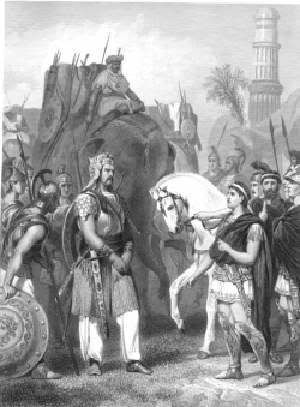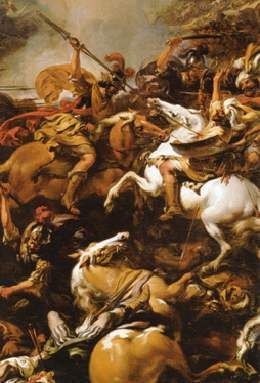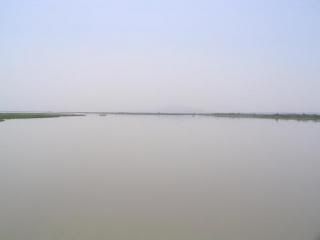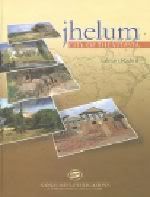 The name Jhelum reminds of Alexander from Macedonian who came to the South Asia sometime in 326 BC.
The name Jhelum reminds of Alexander from Macedonian who came to the South Asia sometime in 326 BC.
He moved from Taxila of Raja Ambhi, whom he subdued without fight, to Kalar Kahar. From there he moved over the Salt Range, turning left, along the western bank of River Jhelum, which he called Hydaspes. He encamped in area of present village Darapur
(a monument is under construction at the site of the camp). Opposite him on the other bank was a Raja Porus. They fought Alexander’s biggest Indian battle which Alexander won, achieving a masterly surprise against the valiant Rajput.
Before moving further, along the river Alexander established a village on west bank of the River and ordered construction of 2000 boats. Greek Admiral Nearches was to arrange wood from nearby higher hills which would be floated down the River and hauled up at this point. He called this village as Boucephila (Present Jhelum city). The Jhelum River passes vying with the residential areas of the city. The mosque inside the river is a famous landmark most commuters on the Grand Trunk Road see even today.
 Alexander’s Naval Chief was assigned the task of boats building on a very large scale. Therefore, the craftsmen on a large scale were gathered, hence the modern colonies in the city were named as Machine Mohallahs (Number1, 2 and 3), because of saw mills. Jhelum became timber market for whole of Punjab over the millenniums. It was only after construction of Mangla Dam that log wood does not float down the River and the city has lost this privilege. There is a plywood factory also, which is flourishing.
Alexander’s Naval Chief was assigned the task of boats building on a very large scale. Therefore, the craftsmen on a large scale were gathered, hence the modern colonies in the city were named as Machine Mohallahs (Number1, 2 and 3), because of saw mills. Jhelum became timber market for whole of Punjab over the millenniums. It was only after construction of Mangla Dam that log wood does not float down the River and the city has lost this privilege. There is a plywood factory also, which is flourishing.
Greeks left marks of their chivalry and martial spirit which mixed up well with the races and clans dwelling in the area. Later, various races such as Turks, Hunas, Persians, Afghans, Mongols, and others including Mehmood of Ghazana, Muhammad Ghauri, Taimur, Babar and their descendants and followers, are found to have campaigned in this strategic region enormously. People who settled here adopted pastoral life and indulged in stock rearing, agriculture came later and soldiering in regular form still much later. Along with the martial races sprang up the artisans, craftsmen, skilled professionals of technical trades for the society to flourish in peace, as a whole.
The British, after annexation of Punjab in 1849 from Sikhs, established administration at district level and Jhelum District, which originally was covering large area including Pindigheb and territory up to River Indus, was delimited later to include tehsils of Jhelum, Chakwal and Pind Dadan Khan, with District Head Quarters shifting from Pind Dadan Khan to Jhelum. During the 20th Century, this city has a proud history of chivalry and achievements.
During World War I, Jhelum provided maximum number of soldiers as a result of which the British recruited very extensively from Jhelum, till their last days of rule. First Victoria Cross, the highest award for gallantry was earned by Subedar Khuda Dad Khan during World War I. Later its equivalent (Nishan-e-Haider) of Pakistan has been won by Major (Shaheed) Raja Muhammad Akram during our war of 1971. At the time of partition of the subcontinent, three out of four senior major generals of Pakistan Army were from Jhelum: Major General Muhammad Akbar commonly known as “recruit⠀�, Major General Nazir Ahmed and Major General Muhammad Iftekhar. Senior most Pakistan Air Force officer was Air Commodore Muhammad Khan Janjua, also from Jhelum.
Later rose up two service chiefs with four star rank, General Asif Nawaz Janjua and Admiral Tariq Kamal Khan. Colonel Muhammad Khan, the author of Bajang Amad and Bazam Araian, and poet Zamir Jafri too have their roots here. Inder Kumar Gujral, who later served as Indian Prime Minister, migrated to India from Jhelum. Military College Jhelum (actually located at Srai Alamgir – town across River Jhelum) was established during the British era. Stone laying was done by the British Prince of Wales, later king Edward the 8th. First entry of students, in 1925, included ‘Alamigirian seniors like Brig Sultan Khan and Brig (Senator) Muhammad Hayat. The institute is now the premier one with top class results, in the country, academically.
Military College Jhelum (actually located at Srai Alamgir – town across River Jhelum) was established during the British era. Stone laying was done by the British Prince of Wales, later king Edward the 8th. First entry of students, in 1925, included ‘Alamigirian seniors like Brig Sultan Khan and Brig (Senator) Muhammad Hayat. The institute is now the premier one with top class results, in the country, academically.
During Pakistan’s wars, officers and other ranks excelled in their performances and a very large number of gallantry awards were won. One has to read Citations of such acts of valour. Then pre World War II and during that war, the number of Junior commissioned officers (earlier-Viceroy Commissioned) who rose to honorary ranks of lieutenants and captains would run into hundreds. Predominance in Defence Services continues and so is service to country.
The people of Jhelum are not sweet for nothing; they have the best quality of Rush Orange (Lockat) grown in salt range. The Jhelum valley (Pabbi area and parts of Salt Range) has been producing pure honey which is rare. In early days, some Yogies and men who indulged in medicine practice had established a centre at Tilla Jogi, because of special growth of useful herbs and plants. Another sweet preparation, a gift from the central square in the city is called ‘Amrassaâà ¢â€šÂ¬Ã¢â€žÂ¢. This sweet is a roasted preparation of rice flour, in pure milk ghee and is usually in small pieces like candies. It is sweet enough only for the taste and is hardly a bar even for diabetics. It is long lasting and its packs would make fine gifts. Do not miss this sweet when visiting Jhelum.
 Jhelum is known for variety of animals and birds and some rare species of deer (huryal). Emperor Jahangir availed of deer shoot in the eastern extremities of the Salt Range (near Rohtas). It is still available but rare. Thanks to unlawful hunting that this specie is at the verge of extinction. Brown partridge, pigeons, sand grouse, quails and some other birds are still to be found. And for bird watchers, there is no other place in this region having such a variety. It is just heavenly a large variety of hymning birds, numerous species of beautiful little sparrows, multi-coloured birds of various sizes, king fishers, birds of falcon family, green parrots, wood peckers, birds of peace, robins. This region provides food and sanctuaries to all of them. Early morning tunes (starting at pre dawn) of their routine singing activity is a treat that can only be personally experienced.
Jhelum is known for variety of animals and birds and some rare species of deer (huryal). Emperor Jahangir availed of deer shoot in the eastern extremities of the Salt Range (near Rohtas). It is still available but rare. Thanks to unlawful hunting that this specie is at the verge of extinction. Brown partridge, pigeons, sand grouse, quails and some other birds are still to be found. And for bird watchers, there is no other place in this region having such a variety. It is just heavenly a large variety of hymning birds, numerous species of beautiful little sparrows, multi-coloured birds of various sizes, king fishers, birds of falcon family, green parrots, wood peckers, birds of peace, robins. This region provides food and sanctuaries to all of them. Early morning tunes (starting at pre dawn) of their routine singing activity is a treat that can only be personally experienced.
Jhelum Work Force which moved into the Gulf States when the latter embarked on their development, financed by oil boon. This force is second to none. There are people of all trades and technologies. The reputation this Work Force has earned makes it most desired. Besides the Middle East, Pakistanis, including medical and engineering fields, are serving well in the US, Canada, Britain and other European countries. Only no body is taking pains to develop the human resources of the country optimally.
It is generally believed in the area that British were really intrigued by one phenomena that people of a particular plateau or valley were found to be tall and strong so they conducted a research; only to come to conclusion that it was the “waterâà ¢â€šÂ¬Ã‚? and ‘saltââ� �€šÂ¬Ã¢â€žÂ¢ of that particular area which is the secret.
The Grand Trunk Road and main Karachi Peshawar Railway Track pass through the city. Commuters can have a feeling of the town once they cross through. Besides history, the city has a rural touch and nothing much have changed here during last couple of decades.



















































I just want to apperciate website, which provide such a good knowledge about Jhelum history. I am also belong to Darapur area. Pakistani Govt. unluckily didn’t pay any attention to such a historical area in Pakistan to attract more international visitors. Jhelum is always ignored by federal Govt. Jhelum can become symbol of Pakistan and historical places. Jhelum never be promoted by media. If Govt. will not take any specail steps to save heritage of Pakistan located in Jhelum then our next generation only see the archeoligical sign of all these historical treasury.
I have always been given to understand that Alexander ,leading his Macedonian troops and about 5000 Punjabi jawans , provided to him by Raja Ambhi of Texila , crossed the river Jhelum( known to the Macedonian historians as Hidaspes)at a place now known as jalalpur sharif near Lilla in jhelum district. Exact place is perhaps Darapur where the Greek Embassy in islambad,has assisted the pakistan authorities to construct a memorial in the name of Alexander , the ” Greek “king, although he was notGreek but Macedonian.The city named after his horse Bucephales was the present day city of Phalia in Gujrat district, in punjab.The horse died on his way back to Alexandria when the king took the route to Makran via Sutlej and passed through the cities of Sangla hill, shorkot and Multan , where he was mortally injured by the Punjabi fighters of Mully tribe
AoA, looks like people have forgotten this. It is interesting to see so much history raised from ‘khak’ – dust. even more interesting is that majority of this history has been written by europeans with their own eurocentric and christocenric paradigms. what is alarming is that ‘we’ are quoting these historians in regards to our land. can some one dig out our historians and our thinkers, and critically analyse their summations to root out the euro and christocenric influences. what about looking at the validity of word of mouth tales of our great grandparents. even the PhD student has been researching western literature, can’t see how her professors and her supervisor accepted the finding without written references, with harvard citation method. (no disrespect ma’am, but your perception is filtered by the prism of your paradigm – but you did correct the blog with fidelity to european research).
i am glad no one has popped more references to blue eyed greeks and jhelumis – o there are a few, really very few, a natural occurance consequence of our genetic makeup.
ok, i hope some one writes something meaningful and interesting,
khuda hafiz.
Good post.
Alexander is thought to have camped near Jalalpur jattan and not at Jhelum and when his favorite horse Bucephalus died he was buried near the Jhelum river bank.
Alexander founded two new cities in the area, Niceaa (victory) thought to be Jalalpur and Bhera,in memory of his horse Bucephalus.
However controvery remains at the exact location of the burial and the city he founded.
Bhera is stated to be the historical town to which the King Porus or Purushotthama belonged
very informative and thank you for bringing it here. perhaps some one can shed light on the following:
i have yet to see academic evidence to show the site of ‘boucephila’, and the last battle ground between porus and sikandar makdoumi (alexander of macedonia). there are many well documented references to hydaspes; the name of jhelum river in antiquity.
blue eyed minority is more noticeable between kabul and kashmir (bearing in mind jhelum city was greater kashmir), however, greeks are not known for blue eyes – i think blue eyed minority is almost a native minority to this region with Arya connection. any lue eyed jhelumis out there?
Phalia near Mandibhawuldin is an interesting reference to Bucephalas – resting place of sikandar’s steed. Has any one in Phalia know of this story?
Sikandar being a muslim, extracted from the sura, that is less tenuous than the seven heavens of the Qurani and the cosmos or particle physics and eastern mysticism – a confluence of belief and Baconian empiricism. where are the tangible links?
Does any one know of the history of Afghana Mosque next to river jhelum – who constructed it and when?
words like pabbi, jogian tilla and mera harken me home.